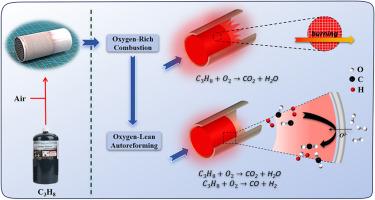0.5 W无隔热管状固体氧化物燃料电池的超快速和稳健启动
IF 8.3
2区 工程技术
Q1 CHEMISTRY, PHYSICAL
引用次数: 0
摘要
本研究提出了一种快速启动系统,该系统将ru涂层堇青石整体式催化剂与3mol %钇稳定氧化锆(3ysz)电解质支撑的管状SOFC集成在一起。通过动态调节C/O比(0.25→0.75),在不保温的情况下触发无焰催化部分氧化(CPOX),使SOFC在20秒内(开路电压:0.9 V)实现超快速启动,并提供0.5 W的最大输出功率(对应于65 mW cm−2的功率密度)。该系统利用了3ysz管状支撑结构和非密封终端设计之间的协同效应,有效降低了快速热循环过程中的机械故障风险。与Ni-YSZ相比,掺杂银和钆的铈(GDC)具有卓越的抗碳沉积能力,使其在0.7 V恒定电压下运行2小时时可以保持其性能,衰减可以忽略不计。该技术解决了快速启停能力、高效燃料利用和抗热震的协同挑战,为特殊任务场景下的便携式应急电源提供了创新的协同解决方案。本文章由计算机程序翻译,如有差异,请以英文原文为准。

Ultra-fast and robust startup of a 0.5 W tubular solid oxide fuel cell without thermal insulation
This study presents a rapid-startup system integrating a Ru-coated cordierite monolithic catalyst with a 3 mol% yttria-stabilized zirconia (3 YSZ) electrolyte-supported tubular SOFC. By dynamically modulating the C/O ratio (0.25 → 0.75), flameless catalytic partial oxidation (CPOX) was triggered without thermal insulation, enabling the SOFC to achieve ultra-fast startup within 20 s (open-circuit voltage:0.9 V), and providing a maximum output power of 0.5 W (corresponding to a power density of 65 mW cm−2). The system leverages the synergistic effects between the 3 YSZ tubular support structure and the unsealed terminal design, effectively mitigating mechanical failure risks during rapid thermal cycling. The superior anti-carbon deposition capability of sliver and gadolinium-doped ceria (GDC) compared to Ni-YSZ allows it to sustain its performance with negligible attenuation while operating at a constant voltage of 0.7 V over 2 h. This technology addresses the synergistic challenges of rapid start-stop capability, efficient fuel utilization, and thermal shock resistance, providing an innovative collaborative solution for portable emergency power supply in special mission scenarios.
求助全文
通过发布文献求助,成功后即可免费获取论文全文。
去求助
来源期刊

International Journal of Hydrogen Energy
工程技术-环境科学
CiteScore
13.50
自引率
25.00%
发文量
3502
审稿时长
60 days
期刊介绍:
The objective of the International Journal of Hydrogen Energy is to facilitate the exchange of new ideas, technological advancements, and research findings in the field of Hydrogen Energy among scientists and engineers worldwide. This journal showcases original research, both analytical and experimental, covering various aspects of Hydrogen Energy. These include production, storage, transmission, utilization, enabling technologies, environmental impact, economic considerations, and global perspectives on hydrogen and its carriers such as NH3, CH4, alcohols, etc.
The utilization aspect encompasses various methods such as thermochemical (combustion), photochemical, electrochemical (fuel cells), and nuclear conversion of hydrogen, hydrogen isotopes, and hydrogen carriers into thermal, mechanical, and electrical energies. The applications of these energies can be found in transportation (including aerospace), industrial, commercial, and residential sectors.
 求助内容:
求助内容: 应助结果提醒方式:
应助结果提醒方式:


